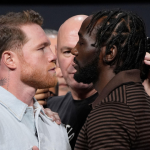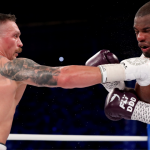IT would be very tempting to look at Andy Ruiz’s physique and put it down to laziness, but his conditioning is still tremendous at heavyweight. Moreover by choosing to fight in a more spherical form Ruiz has removed one of the major stressors of boxing—the diet—and shown that he has no interest in excuses to do with weight.
The result of fighting real heavyweights since his teenage years is that Ruiz is not only deceptively fast and strong for such a short, tubby heavyweight, but you will also struggle to find another man in the top division who looks as serene while under fire from the biggest hitters in the world.
While Anthony Joshua might be an artist’s impression of the perfect heavyweight champion—chiselled from marble, a charming interview and one of the world’s hardest punchers—Ruiz is just as much what the king of the heavies is supposed to be: an absolute champion who will fight anyone of any size.
Disparities in build are more marked at heavyweight than at any other weightclass in boxing and both Anthony Joshua and Andy Ruiz Jr. have worked to get the most out of their builds with their styles. Joshua has been able to use his height and reach to set up his terrific power punching and while his jab isn’t exceptional he was able to make use of it even against the great Wladimir Klitschko.
Joshua is the epitome of the boxer-puncher—his jab serves to needle and hurt, but mainly to draw reactions that allow Joshua to slip in the heavier blows in his arsenal. Against Ruiz, Joshua was using leading the challenger around the ring and using the jab to intercept Ruiz and raise his head, then attempting to rebound off his right foot into a knockout right straight. Ruiz took more of these than any coach would feel comfortable watching their charge absorb.
For Ruiz some of his success comes from making himself shorter. He’s six-foot-two, which makes him a big man in most rooms, but against giants like the six-foot-six Joshua he plays the role of Tyson or Frazier. A good deal of Ruiz’s outside offence is done with body jabs—which take his head off line. If the opponent throws at him while he’s picking with this body jab, Ruiz can dip under their punches and come up swinging.
But Ruiz really makes his money with his hand speed in combination. In a division full of men who are able to end the night in one blow, getting to work as a volume puncher might seem like a daunting task, but as the first fight with Joshua demonstrated—when big hitters trade with Ruiz he can kill them with speed and with his craft.
Ruiz got very little done in the first fight until Joshua had dropped him with a left hook in the third round and moved in for a finish. It was Ruiz’s tremendous speed and comfort under fire that had him dipping under Joshua’s swings and clipping off his own. Ruiz isn’t the kind of fighter who leaves opponents face down and motionless on the mat like Joshua or Deontay Wilder, but he’s a heavyweight throwing with his whole body and that’s more than enough to break the target’s equilibrium.
While it was an absolute pleasure to see Andy Ruiz kick the fight world in the arse and demand the respect he’s due, we cannot exactly claim that Ruiz is proven to have Joshua’s number. Not much happened up to both men suffering knockdowns in rapid succession in the third round and Joshua never really seemed to recover from it.
In each break between rounds the cameras would follow Joshua in his corner and even several rounds after the first knockdown Joshua would ask his coaches again what the knockdown shot had been. Most worryingly ahead of the final round he could be heard to ask “why am I feeling like this?” as his feet became sluggish and his punch output slowed.
One of the big issues coming into the rematch is that Joshua wasn’t holding effectively when he was hurt. Holding is an enormous part of the fight game—especially at heavyweight. You need only look at the careers of Muhammad Ali and Larry Holmes to understand that. When Joshua was staggered he should have been sticking to Ruiz until the referee physically pulled them apart, but instead he would make the odd half hearted reach for Ruiz and then return to covering up.
Study Floyd Mayweather in the few instances that he was hurt in a fight and he can be seen crashing into opponents chest-to-chest, or even ducking in at their waist and standing up into the clinch.
The poor use of the clinch at heavyweight has been an area Ruiz has exploited masterfully through his career. Two heavyweights will swing, fall into each other, and then loosely hug until the referee breaks them. Ruiz will allow his opponent to have these lazy hugs sometimes, but watch Ruiz when he is clinched: he will keep his elbows tight and his forearms on the inside of his opponent’s embrace. Often Ruiz will wait a beat as his opponent drapes their arms around him, and then—before the referee intervenes—he will push away and try to hit them with a right hand on the break.
This is what Jack Dempsey called “The Sneaker” and he believed it to be the most dangerous punch in boxing. The genius of it is that it is only legal if the fighters break on their own terms before the referee says break. Because of the familiar pattern of swing, hug, referee’s break, many heavyweights don’t feel the need to hold effectively in these clinches and give Ruiz the chance to nail them with the sneaker multiple times a fight.
Against Joshua, Ruiz would let Joshua have the clinches—seemingly in no rush—but regularly showed that Joshua wasn’t holding effectively because he could punch freely when he wanted to.
Not only should Joshua be using the clinch when he is hurt, he should be using it to slow down the fight and to prevent Ruiz from working his hands in combination. When Joshua threw one or two blows at a time, he could normally land well enough as he did a good job of walking Ruiz onto his them. But Ruiz would always come back with three or four of his own.
And that leads us to one of Ruiz’s best attributes: durability. It is one thing to have heart in the heavyweight division—where there are plenty of thin-skinned front runners—but it is another to be able to take the punches as Ruiz did in the first fight. Ruiz was hit with some of Joshua’s biggest shots and were it not for the crowd gasping at the fountain of sweat being thrown off his head, it scarcely registered in Ruiz’s performance.
Another important point that could help Joshua considerably is the use of straight blows to the body. Ruiz’s dipping jabs and good head movement kept him away from a lot of Joshua’s big blows and Joshua seemed reluctant to fire the right uppercut except when he was already holding Ruiz behind the head. That is probably because his team likely watched the Joseph Parker fight in the lead up and would have seen Ruiz clapping Parker on the jaw with the left hook in every exchange.
But when the head moves the body doesn’t, and if a fighter gets down in his stance his body jab can be as long from the shoulder as his regular jab. Not only is the body a bigger target, it doesn’t bobble around and slide down the side of your punch as you try to hit it. Ramrod straights to the body physically prevent the opponent from closing the distance. When Joshua began waltzing around the ring upright in round six, Ruiz began putting in right straights to the body himself which could soon be seen to slow Joshua down.
Joshua could also look at the work of Lennox Lewis. When Lewis had men ducking under his jab, he liked to drop his hand on their nape, lean on them a little, and hit them with an uppercut while they had no hope of standing up.
Ruiz was a surprise in the first fight but far from infallible. He ate the vaunted Joshua power and was sent to the mat by it, and there is never any real indication on just when a great chin will fail. But throughout that bout it was Ruiz who was the aggressor and Joshua who was trying to hit and run.
To succeed using the same methods as in the first fight is not impossible for Joshua—but consideration must be given to Ruiz’s strength in flurries. Whether that means pivoting or circling out of the firing line or holding, breaking the combinations at the first or second punch seems like a must to prevent Joshua getting egg on his face again.



